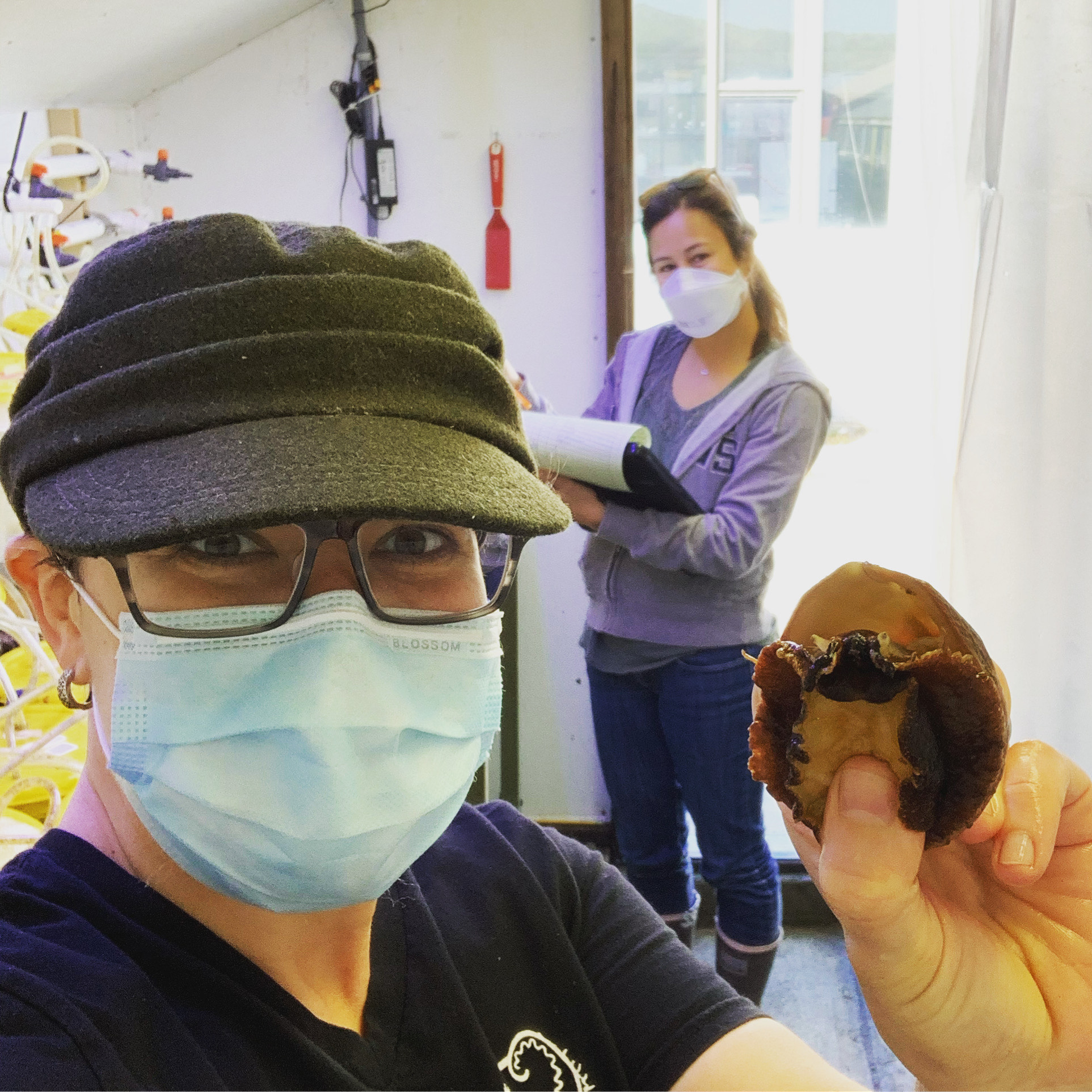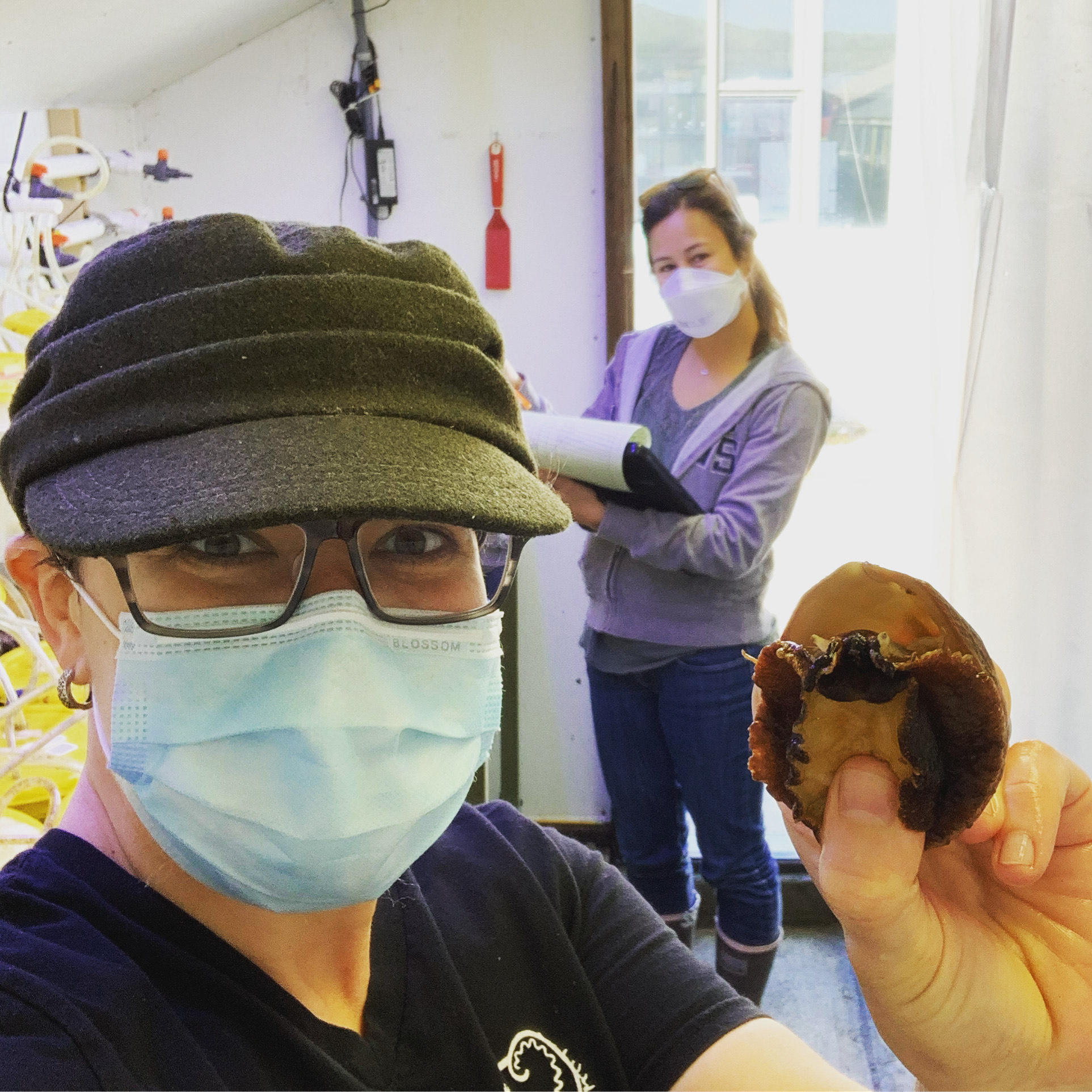Scientist Kristin Aquilino describes the challenges of working with critically endangered white abalone during the COVID-19 crisis.
 Please describe what you do.
Please describe what you do.
I run a highly specialized fertility clinic, health spa, and nursery for a charismatic, endangered sea snail. Officially, I'm the lead scientist for the White Abalone Captive Breeding Program at UC Davis Bodega Marine Laboratory. I'm also a California Sea Grant extension specialist. I hold the federal permit for captive white abalone. Any white abalone that's in captivity in the United States of America, my team and I are responsible for. We have white abalone at ten different facilities in the US, and we also have some at a facility in Mexico.
Part of my job is to coordinate all those partner facilities that have white abalone—either for culturing or outreach—or that put those animals out in the wild. There are two federal permits for white abalone: the captive breeding permit that UC Davis holds, and then one for stocking the animals in the ocean. Once the animals get on the boat to go into the ocean, they're no longer my responsibility. (But I still think about them every day.)
We put some of our captive-bred white abalone in the ocean for the first time a few months ago. For many members of our team, their job now is to track those animals and see how they survive and grow in the wild. My job is to get back to the laboratory to figure out how to make even more white abalone even more quickly so we can save this species.
How have things changed since COVID-19 started?
One of the big impacts has been on our spawning for this year. We sneaked in one successful spawn just before the shelter in place orders. Had we planned that any day later, it wouldn't have happened. It was a good spawning. I'm really excited about that because we have some animals for this cohort in 2020. But normally, we would do another one at the end of April. We won't be doing that, so it will be a much smaller cohort than I would have hoped for.
The other thing that's been impacted is our ability to collect kelp. We get fresh kelp for these animals, usually from beaches. We have figured out how to contact all the right people in order to do that, but it's much more restricted and arduous to get food for the animals.
Most of our experiments are still actually running in the sense that they only require animal care right now. So, I feel lucky in that way. We have one to two staff members at Bodega Marine Laboratory every day caring for our animals. We make sure if there's more than one person there, we're not overlapping in space at all, and we've been able to maintain animal care pretty well through that. But we have some experiments that are set to be sampled coming up, and I don't know what's going to happen with that—if we're going to be able to get all the data that we hope to get from those experiments.
How has this changed the way you work with colleagues?
Most of us have just pared down to basic animal care. Andrew Whitehead at UC Davis and I collaborate on some genetics work, and that's on hold for now. We will be asking for no-cost extensions on most of our grants right now. Things are just going to take longer because we can't do a lot of the sample-processing that we'd be able to do otherwise.
What's been the most challenging part of working with an endangered species during a pandemic?
We can't stop, even for a day. We have to check on our animals twice every day. It's feeding them, it's cleaning their tanks, it's making sure the systems are running. There's a disease that impacts abalone called withering syndrome, and we're trying to keep that out of our captive population, which means a lot of water treatment. We have filtration and UV systems and lots of pumps that need to be maintained. Making sure that that all happens is probably the biggest stress of this. This is the longest we've ever been in this situation, but we've had times when we've been really short-staffed and had to make decisions about how to maintain the animals in really stressful situations that were out of our control. We had the Sonoma County fires in 2017. And last year, we were evacuated, and the lab was shut down for a number of days because of the Kincade fire.
Have any moments stuck out to you in the last few months?
Our spawning started on March 10. We put the abalone parents in this really romantic love potion of hydrogen peroxide, and they spawn. But then you have to culture larvae really intensely for about a week. Toward the end of larval culture, we were being really careful to not be in each other's space. We were trying to social-distance as much as we could. We were really cognizant of hand-washing and not touching our faces and all the things that everyone has been thinking about for the past couple months. And normally, after you settle the animals, there's this really exciting, celebratory moment where everyone's high-fiving and hugging and getting together for selfies. We didn't do that. That was hard. We just accomplished this really amazing thing as a team, and we couldn't celebrate that in the same way we normally would.
You're also very active in outreach. Can you talk a little about what you were doing before the pandemic started and how that's been affected?
I have a lot less bandwidth for it right now. I'm working about half-time because I have small children. My spouse and I are splitting childcare. If I have to cut things, I can't cut animal care. That's not an option. So, there's a lot of other parts of my job that I'm just not able to do right now. But I'm still managing to do some things, like that Facebook Live feed I did the other day. I'm trying to still post and engage occasionally on social media.
Do you have any advice for scientists who want to focus on outreach right now?
There are actually some parts of science that are more accessible in this. All of a sudden, it's a norm to go sit in front of your computer and watch something. Having people's attention for that long is not common. That's something I think scientists can really leverage.
If you're a scientist and you have the ability to tell a story about what you're doing over video, think about what your story is ahead of time. I actually wrote out a bulleted narrative of what I wanted to do for my Facebook Live post. I knew the spaces that I was going to go to and what I wanted to talk about, so I printed those things off and put them in those places. One of the things I really focus on is making sure that I have a take-home message at the end. It can be easy—especially when you're alone, and you're not getting any feedback from people—to just keep talking.
The other thing is: I have a tripod for my phone. I've done video lectures and social media video posts from my lab before. The very first one I did by myself, I said, "I will never ever do this by myself again." Because it's really hard to hold a phone and to do all the things you want to do in terms of explaining or showing people things. Having the tripod really helps.
Is there anything I haven't asked that you'd like to add?
Some of us are asking questions right now about "What is essential for humanity?" Is saving an endangered sea snail so essential for humanity in this environment? I think it is. I think it is part of what makes us human to try to fix things that we disrupt. We are the reason that this species is on the brink of extinction. I think that means that we have a responsibility to do something about that. And that is still true, even with a global pandemic.
###
Interview conducted and edited by Erin Malsbury, 2020 California Sea Grant communications intern




